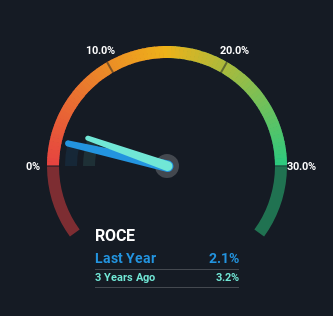Returns On Capital At Explosive (SZSE:002096) Paint A Concerning Picture
What trends should we look for it we want to identify stocks that can multiply in value over the long term? Amongst other things, we'll want to see two things; firstly, a growing return on capital employed (ROCE) and secondly, an expansion in the company's amount of capital employed. This shows us that it's a compounding machine, able to continually reinvest its earnings back into the business and generate higher returns. However, after investigating Explosive (SZSE:002096), we don't think it's current trends fit the mold of a multi-bagger.
Return On Capital Employed (ROCE): What Is It?
For those who don't know, ROCE is a measure of a company's yearly pre-tax profit (its return), relative to the capital employed in the business. The formula for this calculation on Explosive is:
Return on Capital Employed = Earnings Before Interest and Tax (EBIT) ÷ (Total Assets - Current Liabilities)
0.021 = CN¥169m ÷ (CN¥10b - CN¥2.4b) (Based on the trailing twelve months to June 2023).
Therefore, Explosive has an ROCE of 2.1%. In absolute terms, that's a low return and it also under-performs the Chemicals industry average of 5.5%.
See our latest analysis for Explosive

Above you can see how the current ROCE for Explosive compares to its prior returns on capital, but there's only so much you can tell from the past. If you're interested, you can view the analysts predictions in our free analyst report for Explosive .
What The Trend Of ROCE Can Tell Us
On the surface, the trend of ROCE at Explosive doesn't inspire confidence. To be more specific, ROCE has fallen from 3.2% over the last five years. Although, given both revenue and the amount of assets employed in the business have increased, it could suggest the company is investing in growth, and the extra capital has led to a short-term reduction in ROCE. And if the increased capital generates additional returns, the business, and thus shareholders, will benefit in the long run.
On a related note, Explosive has decreased its current liabilities to 23% of total assets. So we could link some of this to the decrease in ROCE. Effectively this means their suppliers or short-term creditors are funding less of the business, which reduces some elements of risk. Since the business is basically funding more of its operations with it's own money, you could argue this has made the business less efficient at generating ROCE.
The Bottom Line On Explosive's ROCE
In summary, despite lower returns in the short term, we're encouraged to see that Explosive is reinvesting for growth and has higher sales as a result. And the stock has followed suit returning a meaningful 77% to shareholders over the last five years. So should these growth trends continue, we'd be optimistic on the stock going forward.
One more thing, we've spotted 3 warning signs facing Explosive that you might find interesting.
While Explosive may not currently earn the highest returns, we've compiled a list of companies that currently earn more than 25% return on equity. Check out this free list here.
Valuation is complex, but we're here to simplify it.
Discover if Explosive might be undervalued or overvalued with our detailed analysis, featuring fair value estimates, potential risks, dividends, insider trades, and its financial condition.
Access Free AnalysisHave feedback on this article? Concerned about the content? Get in touch with us directly. Alternatively, email editorial-team (at) simplywallst.com.
This article by Simply Wall St is general in nature. We provide commentary based on historical data and analyst forecasts only using an unbiased methodology and our articles are not intended to be financial advice. It does not constitute a recommendation to buy or sell any stock, and does not take account of your objectives, or your financial situation. We aim to bring you long-term focused analysis driven by fundamental data. Note that our analysis may not factor in the latest price-sensitive company announcements or qualitative material. Simply Wall St has no position in any stocks mentioned.
Have feedback on this article? Concerned about the content? Get in touch with us directly. Alternatively, email editorial-team@simplywallst.com
About SZSE:002096
Explosive
Engages in the research, development, production, and sale of civil explosives and military products, engineering blasting services, and other businesses in China.
Flawless balance sheet with proven track record and pays a dividend.
Market Insights
Community Narratives



